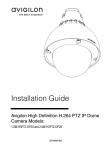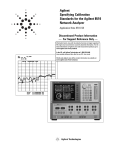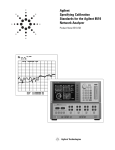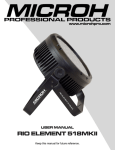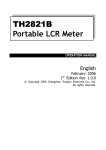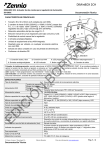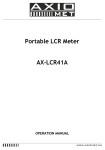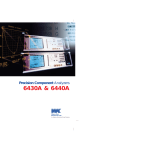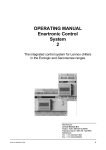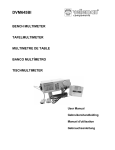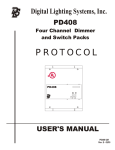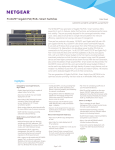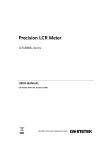Download appnotes/bias current
Transcript
Application Note: 9901 Transformer Characterisation Using External Low Bias Current ! Wayne Kerr Electronics Limited Introduction There is an increasing demand for telecommunications devices such as mobile phones and modems. With this comes an increasing demand on component manufacturers to produce telecomm components. The area of interest in this application note is telecomms transformers. Transformers used in modems will quite often be used in circuits where a small DC current will pass through the primary winding. For transformer manufacturers, it is often imperative that their transformers are tested in a way that simulates the intended operating conditions. Using the technique described in this application note it is possible to provide an extremely accurate DC bias current, which can be used to simulate in-circuit operation. This application note is written around a worked example and it explains how to make an external DC bias current device. The aim is to give an understanding of the external bias design so that it can be modified to suit any low DC bias current application. The technique described uses a 3260A Precision Magnetics Analyser. The same technique can be used in conjunction with the 3255 Inductance Analyser. Figure 1 below shows an example test set-up using and external bias current. Figure 1. Low bias currents It is common for telecomms transformers to have a small DC current flowing through the primary winding. It is important that when transformers are tested, the effects of any current (that will be present when the device is in circuit) are taken into account. In some telecomm transformers the effect of the DC current can be quite significant and a very small variation in the DC current (a few micro amps up or down) can have dramatic effects on the transformers characteristics. For this reason, transformers that will be used with a DC current flowing though the primary need to be tested under the same conditions. The PMA3260A can be used to provide a DC bias current between 1mA and 1A. Although the lower current limit is 1mA, it is not always possible to deliver low level DC bias current with enough accuracy for all applications. However, using the technique detailed in this application note it is relatively easy to obtain a level of current accuracy that is adequate for most applications. Page 1 of 8 Safety Warning WARNING Back EMF! Lethal back EMF potentials can be generated if an inductor under test is disconnected whilst current is still flowing in it. This warning is applicable even at the relatively low currents covered in this application note. NEVER touch the test connections while the direct current is flowing. ALWAYS USE a Safety Interlock, see Appendix 1 ‘Safety Interlock’. Connections The instrument connections to the DUT remain the same. The measurement leads however, need to be intercepted to allow the external bias current to be introduced in to the circuit. Figure 2 below, shows how the measurement leads connect with the external bias. [DW2/27148] Four way BNC link cable PMA3260A [1EVA40100] Kelvin leads External Bias Unit OR DUT Connecting Leads IA3255 Voltage Source Ammeter Figure 2. Construction Details Parts List 1 off General purpose metal box. (Choose size to suit requirement) 1 off 5kΩ Resistor 0.25 Watt (Current resistor) * † 2 off 10µF Capacitor 50V (Blocking capacitors for Drive High and Sense High) * † 1 off Single sided, strip board. (Choose size to suit requirement) 4 off 4mm sockets 8 off BNC bulkheads. (Non-insulated) 4 off Insulating PCB pillars, nylon or similar * Values are specific to each design. Please see the ‘Design Notes’ section for further information on how to select these components. † Tolerances not quoted, as the absolute value is not important. Page 2 of 8 Additional Equipment 1 set of Kelvin leads (fine jaw) [1EVA40100]. Used to connect the external bias unit to the DUT. 1 set of Four way BNC link cable [DW2/27148]. Used to connect the test instrument to the external bias unit. 2 sets of leads terminated in 4mm ‘banana’ plugs. Stabilised power supply (Farnell LT30-1 used in worked example). See notes. Ammeter (Keithley 2000 Multimeter used in worked example). See notes. Design Notes Figure 3. Resistor R1 R1 in the circuit diagram above acts as a V-I converter. When selecting the value for R1 you should consider the bias current required and the output range of the PSU. In this worked example 4k7Ω was chosen, primarily because it was a readily available value but also because it required a relatively high base drive voltage of 4.7V. This meant that to deliver the full range of required current, 1 to 2mA, the voltage range required was 4.7-9.4V. This gave a large margin for fine adjustment of the voltage therefore following the current to be set very accurately. Calculations Current required was 1-2mA. Voltage range of PSU 0-30V. V = I R (R = V / I) ∴ R = 4.7 / 1*10-3 ∴ R1 = 4.7*103Ω = 4k7Ω The power rating of R1 needed to be selected to allow for the maximum voltage available from the PSU. This is because there is not a limiter on the PSU so the possibility of accidental over voltage needed to be considered. The maximum voltage available was 30V. Before the power rating could be calculated, the current through R1 at 30V needed to be calculated. Page 3 of 8 I=V/R ∴ I = 30 / 4.7*103 ∴ I = 0.0064A = 6.4mA With this information, the power rating required for R1 could be calculated. P=VI ∴ P = 30 * 6.4*10-3 ∴ PR1 = 0.192W = 192mW A quarter watt resistor was chosen for this application so that the maximum power was always well within the specification of the resistor. Capacitors C1 and C2 C1 and C2 act as blocking capacitors to prevent the external bias flowing into the instrument. The specification of the blocking capacitor, C2, is critical. C2 will have an effect on the measurement accuracy of the instrument. C1 however is less critical and its value and type matches C2 purely for simplicity of design. Both capacitors must be non-polarised. 10µF capacitors were used in this application. The details of why these were chosen are shown in the calculations below. Calculations The impedance of C2 needed to be relatively low when compared with sense line input impedance, which is approximately 4kΩ. Z of 10µF Capacitor at 1kHz. Z = 1 / (2πfC) ∴ Z = 1 / (2 * π * 1000 * 10*10-6) ∴ Z ≅ 16Ω This introduced a negligible magnitude error and a phase error of approximately 0.4%. Design Note: If the required frequency is higher than 1kHz then a 10µF capacitor will still be suitable. This is because as the frequency goes up, the impedance of the capacitor will reduce, therefore reducing the phase error. However, should the requirement be for a frequency lower than 1kHz then another capacitor value should be chosen. The impedance should be kept to 16Ω or less. e.g. If a frequency of 500Hz is required. The target impedance is 16Ω. So by rearranging the impedance formula in terms of capacitance we can calculate the required capacitor value. C = 1 / (2πfZ) ∴ C = 1 / (2 * π * 500 * 16) Page 4 of 8 ∴ C = 1 / (50265.48) ∴ C = 1.989*10-5 ≅ 20µF The voltage rating of the capacitors needed to be enough to take the maximum voltage that the PSU could deliver. In this application example, the upper voltage of the PSU was 30V so the capacitors chosen were rated at 50V, this gave ample operational margin. Ammeter It is very important to design and build the circuit to allow the ammeter to be connected in series with the DUT. This will give the most accurate reading of the current at the DUT. It is also important to use a suitably accurate (preferably) digital ammeter. Power Supply The power supply needs to meet certain requirements. It must have a stable, finely adjustable output. If the voltage output fluctuates or does not have fine enough adjustment then the required current at the DUT may be unobtainable. This situation will be made worse with an inaccurate ammeter. If possible, a linear power supply should be used. If the only power supply available is switch mode then you need to ensure that the switching frequency will not interfere with the measurement frequency. Switches S1, S2 and S3 None of the switches shown in figure 3 are required for the basic operation of the external bias source. However, S2 and S3 will allow certain operations to be performed that would otherwise require the external bias source to be removed. In addition, though not required, switch S1 is recommended. S1 Bias Current On/Off Fitting a switch (single pole double throw) in the position marked S1 in figure 3 will allow the PSU output to be disconnected from the circuit and connected directly across R1. This removes the need to switch off the power supply for measurements with no bias current. Just switching off the power supply may leave a small residual voltage, which could cause measurement errors. S2 Internal Bias Switch S2, when closed will short out the blocking capacitor in the drive high line. This will allow the internal DC current bias to be used without removing the external bias source. IT IS IMPORTANT TO NOTE THAT THE INTERNAL AND EXTERNAL DC CURRENT BIAS SHOULD NEVER BE USED SIMULTANEOUSLY. S3 DC Resistance The final optional switch, S3, will allow DC resistance measurements. It will also allow an “all frequency trim” to be performed, without having to remove the external bias source. This switch needs to be used in conjunction with switch S2. Page 5 of 8 Build Instructions Figure 4 below shows a basic sketch of the assembled bias current box. Figure 4. 1) The general-purpose case needs to be modified to accommodate the eight BNC connectors required, four inputs and four outputs. The BNC connectors should then be fitted in such a way that the outer, ground, connection makes a permanent contact with the case. The case will therefore form the earth terminal and act as a shielding box. 2) The general-purpose case also needs to be modified to accommodate four 4mm connectors (or similar). Two of the connectors will be used for the voltage input and two for the current measurement. Mount the connectors either on the side of the case or on the lid. The voltage input low terminal should be directly connected to the case, as this is a ground connection. However, all of the other connections for the voltage source and the current measurement should be suitably insulated from the case. Also at this stage, any of the optional switches that are required should be mounted in the case. 3) The external bias circuit should be put together following the circuit sketched in figure 3. The circuit can be built on strip board or similar prototype material. If a large number of bias boxes are required then another method of producing the circuit boards may be feasible. Once constructed the circuit board needs to be securely fitted in to the case. The board should be mounted in the box, ideally on pillars, in such a way that the circuit cannot short out on the metal case. The ground rail(s) should be connected to the case. An ideal way to do this would be to connect the ground rail(s) to a tag on one of the BNC connectors or the Earth terminal 4mm socket. 4) At this point, the circuit board is ready to be wired in, all connections to the BNC’s and 4mm connectors should be made. Any of the optional switches required should be wired in at this stage of assembly. 5) Finally, fit the lid to the case and connect the bias source as described in the section called ‘Connections’. Page 6 of 8 Test Procedure Trimming Before making any measurements with the external bias source connected, an open and short circuit trim should be performed in the normal way. Both trims should be performed as “spot frequency trims”. The reason for performing a “spot trim” being that an "all frequency trim" includes a trim at DC. The blocking capacitors prevent DC measurements and will cause the trim to fail. Also since each bias source will be designed for use over a very narrow, or even fixed, frequency range it is not necessary to perform an all frequency trim. Instrument set-up Setting DC bias Connect the ammeter into the circuit as indicated in figure 3, in series with the DUT. Adjust the voltage to give the desired current and replace the ammeter with a shorting link. Important note: If a different type of transformer is to be tested, then the voltage should be readjusted to obtain the correct current for the particular DUT. Setting measurement conditions Note the following instrument set-up only applies for this particular example. Each bias box will generally be designed to meet a specific specification. Therefore, each box will be designed to work under the desired test conditions for the DUT. Instrument should be set to: Frequency: AC Drive Level: Internal DC Bias: External DC Bias: Measurement Parameters: Measurement Mode: Range: 1kHz 0.1Vac 0A off 1-2mA. (Set by adjusting voltage source.) L, Q, Series equivalent circuit, and Slow measurement speed. Repetitive. See notes below. Range settings This method of generating DC bias forces some restrictions on the ranges and drive levels available. These restrictions are indicated in the table below. Range 1 2 3 4 5 Impedance Range <1Ω <10Ω <50Ω >50Ω >250Ω Drive Type Idc max. Vac max. I drive I drive I drive V drive V drive 50mA 50mA 30mA 30mA 3mA N/A N/A N/A <0.5V <0.5V Page 7 of 8 Measurements Once the instrument is set-up with the DUT in place, all of the required inductance measurements can be taken in the usual way. Refer to the instrument user manual for more specific measurement instructions. If the readings are blanked by the application of the bias current, a range error has occurred. To overcome this try reducing the drive level until the reading updates. Appendix 1 For reasons of safety, an interlock should be used in conjunction with the external bias. The diagram below shows the diagram as recommended for internal bias protection. This can easily be adapted for external bias. Ideally, the DUT should be housed within a box that has an interlock door. For further details please refer to you user manual. Figure 5. Page 8 of 8








